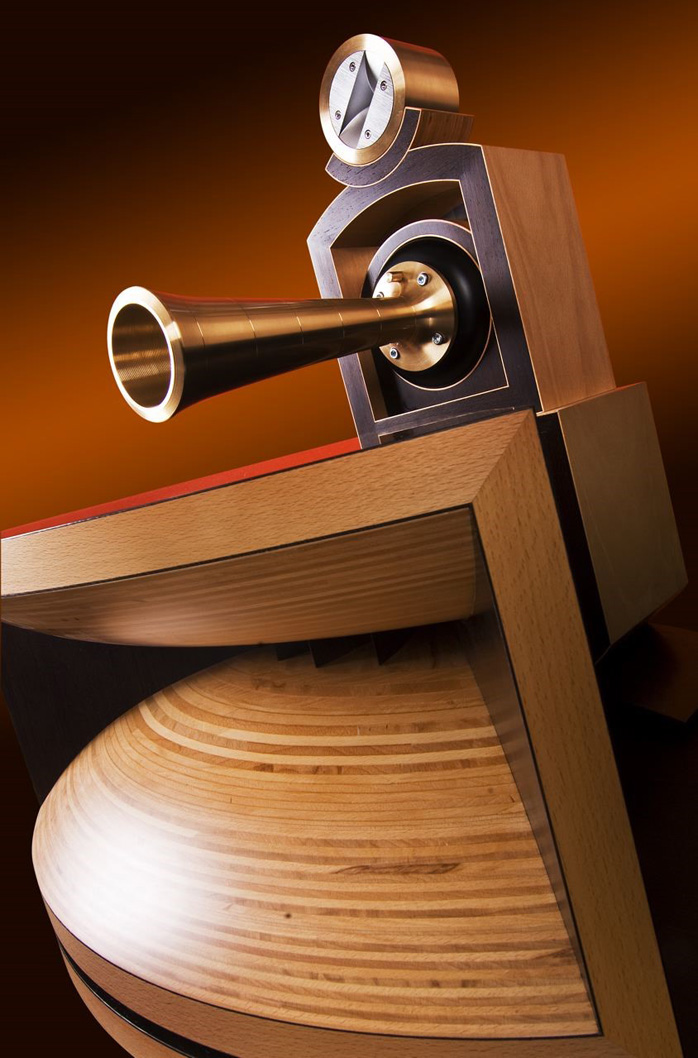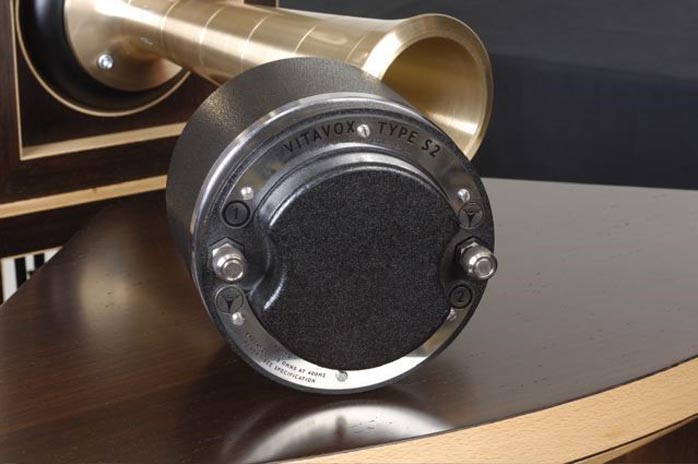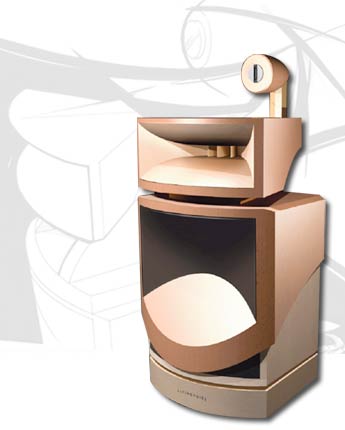This review page is supported in part by the sponsors whose ad banners are displayed below |
 |
|
The Air Scout was introduced in 1995. "With what we had learned from working on the Air Partner project with David Young at Vitavox and from our subsequent experiences in the field, we decided to produce a much more compact and domestically accommodating solution. For the Air Scout we utilized the same mid and high-frequency system that we had developed for the Air Partner but coupled it to a shorter rear-loaded horn fitted with a front-firing 12" paper woofer.
|
|
|
"Accepting the fact going in that the Air Scout would not dredge the lowest registers of the frequency range, it nonetheless captured the immediacy, energy and vitality of the live musical performance. This was a refreshing and awakening experience to the listener and offered a presentation that deviated diametrically from that of the prevailing culture of mid 80dB sensitivity loudspeakers. The Air Scout said a fresh and revitalizing ''Good Morning!'' to a great many music lovers, winning the devotion of the Jazz police in particular. It was equally at home on a 20-piece Latin ensemble and a 50-piece Baroque chamber orchestra with choir.
|

|
"It soon became clear that an optional subwoofer was going to be very useful if we were to broaden this speaker's musical compass. The development of the subwoofer once again involved Vitavox technology and was a scaled revision of their enormous 2 x 15" woofer 'W' bin. We worked on a geometry that eventually became the RW24 Bass Bin, so called because it used a bifurcated (re-entrant) 'W' horn driven by two paralleled 12-inch drivers. By using the same horn-loading technology across the full bandwidth, the Air Scout RW24 system had an integrity that eluded hybrid loading approaches.
"With a whopping 104dB/@1m sensitivity, the Air Scout RW24 loudspeaker system was some 17dB/watt more efficient than a loudspeaker with an average 87dB/w @1m rating. This specification allowed full advantage to be made of inherently superior class A valve electronics with power outputs as low as 3 watts."
Although in conventional terms the Air Scout was still a big loudspeaker, its tight rectalinear and modernist styling by American architect Beau Herr gave it a friendly face. The Air Scout's cabinet dimensions were 1150 x 625 x 570mm HxWxD, attendant gross weight 95kg/ea. Frequency response was 50Hz to 21.5kHz, recommended amplifier power from 5 - 100 watts. The RW24 Bass Bin measured 840 x 1400 x 600mm HxWxD and each unit weighed 50kg.
|
 |
As became apparent during the above conversation, the subsequent Vox Olympian project is informed by Living Voice's appreciation of and extensive work with Vitavox drivers in their previous Air Partner and Air Scout models. By 1999 the growing success of Vitavox’s lucrative military and maritime business required them to transfer driver production to Octave Audio in Bristol. This move ensured continuity of both quality and supply of these famous drivers. Just as importantly, it brought Octave Audio and Living Voice into a powerful constellation of a productive and highly creative business relationship.
|
The Vox Olympian bass driver is the massively constructed Vitavox AK151. Designed specifically for horn loading, it uses a powerful AlNiCo magnet assembly, a light straight-sided paper diaphragm and an 8-ohm coil wound on a 57mm diameter former. It employs a custom suspension developed specifically for the Olympian. This unit is loaded by a modified exponential compound horn that is hand-fabricated from custom laminated and precision calibrated 30mm solid beech. "This is an illustrious and expensive choice of cabinet material not to be confused with its more prosaic cousin Birch ply which Living Voice uses only for prototyping work. Beech is an extremely dense, uniform and stiff hardwood that is ideally suited to this task."
|
|
|
The midrange driver is the famous Vitavox S2 AlNiCo compression driver. It uses a three-inch diaphragm and a custom suspension made specifically for the Vox Olympian. It is loaded via a cast bronze manifold by a 300Hz exponential horn again hand fabricated from solid laminated, calibrated, premium Beech. "This in itself is a work of art, just look at those beautiful end-grain laminations!"

Continuing upwards on the driver array, the remaining two horn-loaded units are of Japanese providence, TAD to be precise. Their 1-inch throat model TAD2002 combines a Beryllium dome with an Alnico 3 motor. This driver has a useable bandwidth of 1kHz to 27kHz, an extraordinary specification. Living Voice however uses this unit only for HF duties by loading it with a modified exponential horn fabricated from seven pieces of cast LG2 bronze. The final unit at the top is a modified TAD Exclusive ET703, a slot dispersive compression driver again with a Beryllium diaphragm. This unit has a useable frequency range of 5kHz to 45kHz but Living Voice only runs it above 15kHz as a super HF driver.
|
 |
The presence of this twin tweeter arrangement is perhaps the most surprising element of the Vox Olympian's profile. Anticipating confusion and armchair criticism from the peanut galleries, Kevin smirked. "All I was interested in was achieving the best possible result in musical terms. I am interested in music and in particular capturing human expression in musical performances. All design decisions were subject to this principal consideration. For example, we know that a drive unit’s behavior in its stop band (where it is progressively rolling off) is just as important as its behavior in its pass band. It is therefore preferable to operate the drive units comfortably within the most linear part of their bandwidth.
"I experimented with a lot of HF drivers and found that those which worked to my liking at 5kHz were attenuated or untidy by 20kHz. On the other hand the HF drivers that I was happy with at 20 or 30kHz sounded weak and fragile at frequencies below 10kHz even with third order filters. A two drive-unit HF solution was the best way to resolve this problem and achieve the results I found musically satisfying. We therefore operate the very high frequency unit or super tweeter only in its uppermost bandwidth, thus allowing it to behave tidily below its pass band. Similarly the main HF unit is used well above its low-frequency limit. This driver is loaded with a long bronze horn which has two functions. On the one hand it provides a strong and assured coupling of the driver to the room, something I find musically important.
|
|
|
"On the other hand it provides a low-pass acoustic filter which helps us achieve a seamless integration with the super tweeter above it. This is an elegant solution that I find musically insightful, persuasive and engaging. I've worked on this project for 6 years and tried a great many reasonable and unreasonable permutations and this HF arrangement was very much to my liking. In the empirical development process, you discover odd little things that have great significance, are impossible to quantify but need to be understood and replicated. Similarly things of great theoretical importance can be quite benign.
"For example I did not find that time-aligning the bass and midrange drivers was musically that significant. What I did find critical however was the time alignment of the midrange, HF and super HF drivers. These drivers are adjustable for output level via attenuators on the back of the cabinet. This allows for adjustments to be made to the tonal balance to suit different room types and sizes as well as partnering electronics. The super HF unit and HF units are therefore independently mobile relative to the midrange to allow in-situ fine tuning of the phase alignment. The super tweeter is mounted on a mobile carriage with a calibrated helical worm drive. Similarly the HF driver and horn is also independently mobile against a calibrated inlaid bronze index.
|
 Concept drawing of single-tweeter Olympian hornspeaker
Concept drawing of single-tweeter Olympian hornspeaker |
|
 |
"Also of great significance was the choice of materials throughout. A prior bespoke project involved casting a loudspeaker carcass out of LG2 bronze. This material had some very helpful and unexpected characteristics that I came to greatly admire. We therefore decided to prototype the HF horn of the Olympian in LG2 bronze. Simply replacing our preferred and highly evolved cast aluminum geometry with cast LG2 bronze was a delight and wonderful improvement.
"It revealed a lithe, supple and succulent quality to the tonality, a radiant and naturally heterogeneous quality that made the aluminum sound pale, pastel and dry in contrast. We finally built the Olympian's modified exponential HF horn geometry from seven threaded sections of LG2 bronze*. The sections screw together on fine threads and are separated by a combination of paper and Sylomer** gaskets, which damp resonances in the bronze.
|
|
"The inside of the horn has a rippled convoluted surface relief machined into it. The amplitude of these convolutions decreases towards the throat where the profile is completely smooth. This surface treatment has a surprisingly beneficial influence. The biggest hurdle is finding the time and money to support these endless prototyping explorations.
_____________________
* LG2 is an alloy of 85% copper, 5% zinc, 5% lead and 5% tin
** Sylomer in the particular form used is the standard in hi-tech vibration isolation of passenger cabins in pleasure cruise ships from the hull and engine compartments.
|
|
|
|
|
|
 |